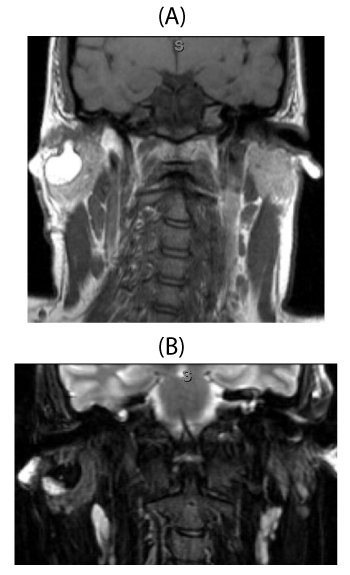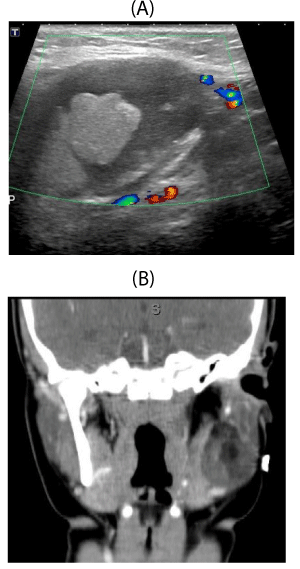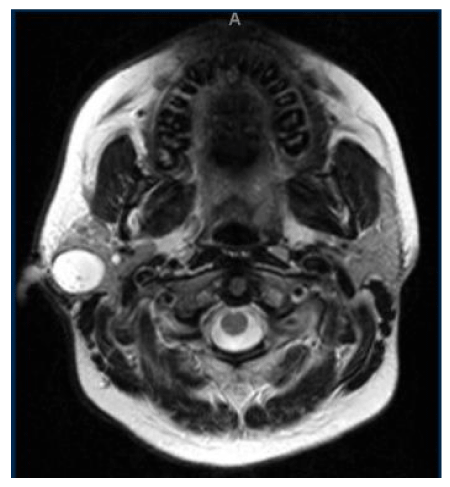Global Journal of Medical and Clinical Case Reports
Atypical Imaging Appearances of First Branchial Cleft Anomalies: Two Pathologically Proven First Branchial Cleft Anomalies Containing Fat on Imaging
Akash Meesa1, Priyanka Meesa2, Indu Rekha Meesa3* and Suresh K Mukherji4
2Priyanka Meesa, High school junior, Fort Wayne, IN, USA
3Indu Rekha Meesa, Neuro and Peds Radiologist, Synergy Radiology, Fort Wayne, IN 46818, USA
4Suresh K. Mukherji, Department of Radiology, Chief Medical Officer & Director of Health Care Delivery, Michigan State University Health Team, USA
Cite this as
Akash M, Priyanka M, Indu Rekha M, Suresh KM (2017) Atypical Imaging Appearances of First Branchial Cleft Anomalies: Two Pathologically Proven First Branchial Cleft Anomalies Containing Fat on Imaging. Glob J Medical Clin Case Rep 4(3): 055-057. DOI: 10.17352/2455-5282.000048Introduction
Branchial anomalies (BA) are developmental lesions that are believed to be either vestigial remnants resulting from incomplete obliteration of the branchial apparatus or the result of buried epithelial cell rests. They are classified as either first, second, third, or fourth according to their proposed pouch or cleft of origin and are relatively common findings. The incidence of BAs depends on the age of the patient and the specific type of anomaly. Some anomalies might be very small and not present until they become symptomatic from an inciting event such as infection or trauma. Most radiologists are familiar with the classic findings of the most common forms of 1st and 2nd BAs. However, some BAs can have a varied imaging appearance and may be misdiagnosed. In this paper, we present two cases of pathologically proven first branchial cleft anomalies with atypical imaging appearances.
Case 1
A 24 year old male patient presents to the clinic with a right parotid mass. Contrast enhanced head and neck MRI was performed which demonstrated a fat containing lesion in the right parotid gland. The mass was surgically resected and sent to pathology. Pathology confirmed the mass to be a branchial cleft anomaly (Figure 1a,b).
Case 2
A 10 year old girl presents to the clinic with a left parotid mass. Ultrasound over the area of concern demonstrated an echogenic mass in the left parotid gland. A contrast enhanced CT scan was then performed which demonstrated a fat containing mass in the left parotid gland. The mass was surgically resected and sent to pathology. Pathology confirmed the mass to a branchial cleft anomaly (Figure 2a,b).
Discussion
In this paper, we present parotid masses in two different patients that on CT, MRI and US contained areas of fat. The cases are part of a larger retrospective review study of the branchial cleft anomalies we had performed to determine the diagnostic accuracy of properly diagnosing branchial anomalies. Prior to performing the study, institutional review board approval was obtained. The pathology database was queried for a list of pathologically proven branchial anomalies (BA) for adult and pediatric patients that had undergone surgical excision of a neck mass between 1/1985 and 12/2012. These studies were cross-referenced with imaging to determine which pathologically proven cases had correlative imaging. All of the imaging studies and reports were then retrospectively reviewed and the branchial cleft anomalies were classified based on the branchial arch origin by a board certified, fellowship trained neuroradiologist.
During this retrospective review, we came across several branchial cleft anomalies with atypical imaging findings. Two of those cases were described in this paper. Histologically, the diagnosis of a branchial anomaly was determined by the presence of stratified squamous epithelium with lymphoid tissue. Columnar respiratory epithelium was occasionally present. In addition to the squamous and respiratory epithelium, some cysts also contained various other components. One of the masses discussed in this report contained benign fibro adipose tissue with overlying squamous and respiratory epithelium on pathology. Pathology report for one of the other excised masses was described as containing skin, fibro adipose tissue and skeletal muscle with squamous epithelial-lined track consistent with branchial cleft cyst.
First branchial cleft anomalies account for less than 8% of all branchial abnormalities [1,2]. The external ear canal is a derivative of the first branchial cleft and anomalies of the first branchial cleft often involve external ear canal structures [3]. They have been classified as Type 1 or Type II by Work in 1972. Type 1 is associated with the first cleft while type 2 is associated with the first cleft and the first arch and perhaps even the second arch [4]. Both are duplication anomalies: type 1 is a duplication anomaly of the membranous external canal and type 2 of the membranous external canal and pinna (cartilaginous elements) [4]. From an embryological standpoint, type 1 is considered to be of ectodermal in origin and type 2 to be both ectodermal and mesodermal in origin. This could explain the presence of fat within the branchial cleft anomalies we discussed in this paper.
The characteristic position of the type 1 lesion/cystic mass is in the postauricular area, medial, inferior and posterior to the pinna and concha. The lesion extends superiorly, paralleling the external auditory canal, in close proximity to the main trunk of the facial nerve and ending in at or near the bony plate at the level of the mesotympanum. The parotid gland tissue is also associated with the part of the lesion located anteriorly [4].
First branchial cleft cysts can appear as a unilocular or multilocular cystic mass either within, superficial to, or deep to the parotid gland. Occasionally a tract may terminate anywhere along the external ear canal and middle ear cavity. Cyst wall thickness and enhancement are variable depending on the degree of recurrent infections. CT and MR imaging will demonstrate the classic imaging findings of cystic mass and therefore it would be difficult to differentiate a first branchial cleft anomaly from other cystic mass of the parotid gland (Figure 3). If there is involvement of the deep lobe of the parotid gland, then it may extend into the adjacent fat-containing parapharyngeal space [5].
Parotid masses can be benign and malignant. Differential diagnosis for some benign mass like presentations include first branchial cleft anomaly, epidermoid cyst, dermoid, lymphoepithelial cyst, abscess, Warthin’s tumor and pleomorphic adenoma. Differential for malignant parotid masses include mucoepidermoid carcinoma, adenoid cystic carcinoma, acinic cell carcinoma, carcinoma ex-pleomorphic adenoma, squamous cell carcinoma and adenocarcinoma.
Conclusion
This case report illustrates how branchial cleft anomalies can sometimes present with atypical imaging findings and therefore it is important to include these in the differential in the appropriate clinical setting.
Ramon Sanchez, MD University of Michigan
- D’Souza AR, Uppal HS, De R, Zeitoun H (2002) Updating concepts of first branchial cleft defects: a literature review. Int J Pediatr Otorhinolaryngol 62: 103-109. Link: https://goo.gl/K6dM4F
- Stokroos RJ, Manni JJ (2000) The double auditory meatus-rare first branchial cleft anomaly: clinical presentation and treatment. Am J Otol 21: 837-841. Link: https://goo.gl/MjJXME
- Tham YS, Low WK (2005) First Branchial Cleft Anomalies have Relevance in Otology and More. Ann Acad Med Singapore 34: 335-338. Link: https://goo.gl/7m8P1f
- Work WP (1972) Newer Concepts of First Branchia Cleft Defects. Laryngoscope 32: 1581- 1593. Link: https://goo.gl/QhjNrF
- Koeller KK, Alamo L, Adair C, Smirniotopoulos JG (1999) Congenital Cystic Masses of the Neck: Radiologic-Pathologic Correlation. RadioGraphics 19: 121-146. Link: https://goo.gl/EjE7iM

Article Alerts
Subscribe to our articles alerts and stay tuned.
 This work is licensed under a Creative Commons Attribution 4.0 International License.
This work is licensed under a Creative Commons Attribution 4.0 International License.



 Save to Mendeley
Save to Mendeley
